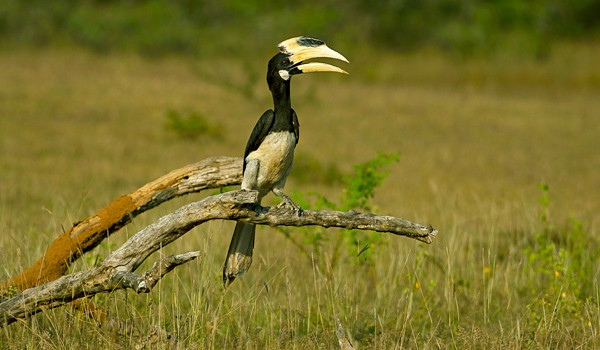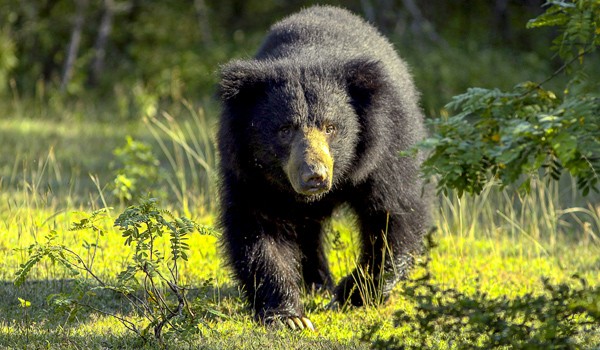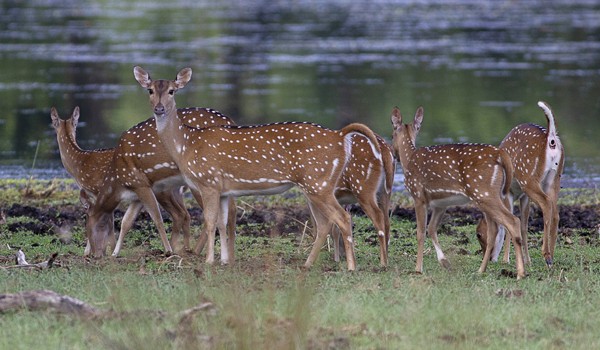Considered to be one of the oldest and best-known, Yala National Park lies in the extreme south of Sri Lanka bordering eastern and southern coastlines. Spread across close to 100,000 hectares of land, this is the second-largest and most-popular national park in Sri Lanka. With the highest visitations each year, Yala National Park is the best place see leopards in the wild, together with an exciting range of mammals, birds, reptiles and flora.
Yala National Park has diverse terrains with equally complex ecosystems consisting of moist and dry monsoon forests, semi-deciduous forests, thorn forests and grasslands. As it is surrounded by the Indian Ocean, both fresh and saltwater wetlands are part of the landscape. The park is divided into five blocks. Block 1 is the most popular amongst visitors due to high density of Sri Lankan leopards. Block 2, 3 and 5 are less crowded and suitable for all round wildlife encounters, while block 4 remains closed for visitors. The unique ecosystem of Yala provides thriving habitats for Sri Lanka’s larger and better-known mammals including the endemic Sri Lankan leopard, the Sri Lankan elephant and the sloth bear. Given the geographical positioning, an annual elongated drought results in the park’s Block 1 closing to visitors from August to September each year.

Yala National Park is home to 215 species of birds including 7 endemic species. The park has 90 species of waterbirds with almost half being migratory. Forty-four species of mammals reside in the park and a recorded 47 species of reptiles, 6 being endemic. The coastline of the park records visitors from all five globally endangered sea turtles. The lagoons and marshlands are home to a number of fish and invertebrates. This park is famous for the best sightings of leopards in the wild. The Sri Lankan leopard (Panthera pardus kotiya), a native subspecies, is the apex predator of the jungle. This species is on the red list of the International Union for Conversation of Nation (IUCN) of endangered animals. Due to high density of leopard population, Yala National Park is one of the preferred places to view leopards in their natural habitat. The park receives rainfall mostly from the North Eastern monsoons between November and January and remains dry during most parts of the year.

The average temperature is around 27° C while the highest can reach up to 30° C. However, the north easterly winds can make the place cool and chilly in the early morning hours especially when safaris begin. Yala National Park has a rich history behind it. It has been referred to in the ancient Indian epic Ramayana. The most notable history is much later when the region known as Ruhuna, encompassing Yala, was a thriving kingdom of its own, evidence of which still exists today in the ancient tanks (manmade water bodies) and ruins of buildings and monasteries that still remain in and around this area. During British rule the park was a hunting ground for the colonial elites. This area was known to be the home of more than 1,000 Buddhist monks who were on the path to enlightenment and thus holds places of silent worship such as Sithulpawwa ancient monastery, a beautifully place between the forest and the rocks with phenomenal views of the park

Yala is a great place to visit year round. Block 1 of the park (with the highest leopard density) generally closes when the waterline recedes during September to October each year. The best time to visit Yala National Park for leopard sightings is June, July, August although year around sightings are good. Between November to April, you are likely to see more migratory birds in the park as opposed to other times of the year. For birders the latter part of the year would be the best with more numbers and varieties. Being the most-popular and most-visited, safaris in the park can get busy and crowded. The park has two entrances, the more popular and busy entrance Palatupana, and the less busy entrance Katagamuwa. The latter has less traffic to enter the park. However, crowds tend to gather in the event of a leopard sighting.

Safaris in Yala are conducted in jeeps. The type of jeep ranges from Land Rovers to converted Toyota Hilux mostly with open fronts for best viewing. Travellers are not allowed to get down other than in a couple of designated areas that are designed to break the journey. The favourite places are near the Menik River and by the ocean where the 2004 tsunami memorial is placed. The latter is definitely the more spectacular choice for a picnic breakfast or for the afternoon tea break. Morning safaris into the park commence as early as 6.00 a.m. from the park entrance and lasts between 3-4 hours. Afternoon safaris commence at 2.30 p.m. from the park’s entrance again lasting up to 3.5 hours. The park closes at 6.00 p.m. for visitors. A wide range of accommodation is available to fit every budget and style including luxury resort type properties, bespoke upmarket tented accommodation, comfortable/modest tented accommodation, midrange hotels and villas and hostels.

Of our own personal experiences, we have a couple of standout memories from Yala National Park including a sloth bear rolling down from a tree in Thalgasmankada inside the park, quite obviously having lost his balance in the tree. He was also oblivious to a handful of human spectators. We also recollect a rare sighting of a chase and the play of two leopards in the process of mating – unsurprisingly, one of the best sightings we have had. Yala National Park is comfortably reached from Colombo’s International airport within a 5-hour drive on the southern expressway. It can also be reached through private scheduled or charter flights if you are looking for a more luxury option. On a private tour to Sri Lanka a visit to Yala National Park will best fit between a beach stay on the south coast and tea plantation stay thus making it an exciting stopover.

Here are sample itineraries for wildlife tours of Sri Lanka featuring Yala National Park. Click below to read more about any of these Yala tours or get in touch to receive a detailed, tailor-made itinerary.
A leisurely paced holiday in Sri Lanka for familie...
13 DAYS/12 NIGHTS
Family Holiday Sri Lanka
Read MoreIts rolling hills carpeted by tea plantations and...
10 DAYS/9 NIGHTS
Quintessential Sri Lanka
Read MoreDiscover the best wildlife experiences Sri Lanka h...
17days/16nights
Wildlife of Sri Lanka
Read MoreA two-week journey that will introduce families wi...
13 DAYS/12 NIGHTS
Sri Lankan Family Adventure
Read MoreWith ancient Buddhist temples, the impressive Sigi...
15 DAYS/14 NIGHTS
Classic Sri Lanka
Read MoreA fabulously romantic honeymoon featuring some of...
13 DAYS/12 NIGHTS
Honeymoon Sri Lanka
Read MoreAmazing trip! We absolutely loved it. Sri Lanka is now a country we would definitely like to go back to and explore further.Thank you so much for all the work you did in putting the trip together for us. It was a great mix of places for us to get a good feel of the country. We will be encouraging all our friends to go to Sri Lanka.